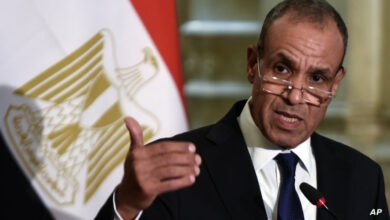Egypt Independent interviews historian Craig Daigle about his seminal work “The Limits of Detente: The United States, the Soviet Union, and the Arab-Israeli Conflict, 1969-1973” unpacking the myths surrounding the 1973 October Arab-Israeli war. In this final part of the interview, Daigle discusses the intricacies of implementing the ceasefire and the American and Soviet positions on the continuing conflict.
Egypt Independent: How did the Israelis take advantage of the negotiation period before declaring ceasefire?
Craig Daigle: In that turn, they had less concerns about occupying more territories, than they did to really put a final defeat on the Egyptian army. They really wanted to make sure that the third army was defeated. So they had stopped. And then fighting broke out on 23 October. The Israelis say it was the Egyptians who were trying to get out. That may be the case, but the Israelis responded aggressively and continued to violate. The Israelis violated the ceasefire.
EI: What was the Israeli response to (Henry) Kissinger’s orders to ceasefire? To what extent were the American and Israeli perspectives in this critical moment congruous?
Daigle: The Israeli military and even most of the Israeli leadership was very upset with Kissinger for negotiating a ceasefire without consulting them. There was a breakdown in communications in Moscow that would have send the Israelis updates, but they didn’t consult the Israelis. So when he got to Israel, he flew right from Moscow to Tel Aviv to meet with [former Israeli Prime Minister Golda] Meir, and he had three meetings in Israel. One meeting was a private meeting with Meir, another meeting was with the Israeli cabinet and a third meeting was with the military leaders. In all three meetings, the Israeli leadership — both civil and military — was upset because it didn’t make sense to stop where they were. There weren’t clear lines. The ceasefire called for lets say, the parties need to stop fighting, as of where the forces where at 12 pm on 22 October. But, nobody really knew where those lines where. Nobody had a map out and said: “At 12 pm this is where the forces were.” So, they looked at Kissinger and said: “this ceasefire doesn’t make sense,” it doesn’t work for us, it can leave us in a weak position. And, if you give us two more days, we can defeat the army, we can come to defensible borders." So they wanted a further delay in the ceasefire. Kissinger said: “listen, I can’t give you two days. Two days is too long. But it’s going to take me 12 hours to fly back to Washington," and he made a stop in London on the way back. “What you choose to do between now and when I get back to Washington, that’s up to you."
Basically, he knew the process. He knew that the Soviets would protest to him, and they couldn’t make that protest if he was flying in the air, so he knew that the longer he travelled, it was good for the Israelis. That's one of the reasons he went to Moscow to meet with (former Russian President) Leonid Brezhnev. He knew that by travelling to Moscow, that’s going to give the Israelis more time on the battlefield to accomplish what they want. He gives them the green light that says: “Listen, I can’t give you 48 hours, but I can probably give you 12 to 24 hours to advance your positions to a better line, and then you’re going to have to stop fighting. When the fighting continued after that 24-hour period, that’s when Kissinger got upset.
EI: So how was the ceasefire imposed?
Daigle: Finally on 24 October, Kissinger calls the Israeli ambassador and says: “Listen, you can only make Brezhnev look like a fool for so long.” Because basically Brezhnev had worked out this ceasefire and put his neck out on the line, so if the Israelis continued to violate the ceasefire it’s up to Brezhnev in many ways to uphold it. So what Kissinger is telling the Israelis is Brezhnev is going to have forces sent to this region if you don’t cut this crap out. Stop fighting because Brezhnev looks weak and you’re making him look weak. So Kissinger told this to the Israelis, who continued to advance. That’s what happened on the night of 24 October. Brezhnev sent a message, basically saying that if the Israelis don’t back off and return to the ceasefire lines of 22 October, the Soviets would send forces unilaterally. He wanted it as a joint US force, but he said if the US didn’t want to join, they were going unilaterally. And that’s when Kissinger put forces on a military alert on the night of 24 and 25 October and the crisis by the following morning subsided.
EI: We have known later that (former Egyptian President Anwar) Sadat refused (former Presidential Chief of Staff Saad) al-Shazly’s plan to liquidate the Israeli infiltration between the Second and Third armies. I wonder what made the Egyptian army abide by the ceasefire although the Israelis were breaching it and advancing in the Western bank of Suez Canal?
Daigle: That was what happened on 24 October exactly. On the night of 24 October after the Americans placed their forces on military alert, they recalled troops that were on leave. And they made it appear that the US was going to send forces. They started moving carriers and ships to the Mediterranean, so they’re making it appear that they were ready to intervene if needed. But they really did not want to send troops into the Middle East. You have to remember that in 1973 this was only nine months after the Paris-peace accords and this would be a sign of war, and Vietnam just ended, so the Americans didn’t want to get involved in another war in a far away land. So by pushing to the alert, Kissinger was saying to the Egyptians and to the Soviets “We are prepared to intervene if necessary.”
EI: Finally, as a historian, how do you estimate the conclusion of 18 days of fighting in both military and political terms?
Daigle: Obviously, the balance of power changed completely after Sadat advanced the attack following 14 October. Militarily, at the end of the war there was not one Egyptian soldier or one Syrian soldier on Israeli territory. The Israelis had moved beyond the Suez Canal, to the west side of the canal, they had moved further into Syria. So, it was a military victory for the Israelis. However, the war was also a political victory for Sadat, because his aims were not to defeat Israel militarily. His aims were to get the parties moved off their frozen positions, to get Kissinger actively involved. If you look at the documents leading up to 1973, what you see in early 1973 is that Kissinger doesn’t want to get involved. He’s fine with the status quo. And that’s what Sadat was trying to change. In (former US President Richard) Nixon’s first term he couldn’t do it. In 1973, Muhammad Hafiz Ismail, Sadat’s adviser for national security affairs, came to meet Kissinger in secret negotiations and he went back and said, “nothing is going to happen. Kissinger doesn’t want to get involved.” Kissinger was more interested in Europe and China; he said in a big speech that 1973 is going to be the year of Europe. The Middle East for him was a sideshow. So Sadat was trying to change that attitude. Two weeks after, Kissinger showed up in Egypt and they began the process of diplomacy and they moved the Middle East to the front of foreign policy agenda from 1974 to 1976. Sadat shook the myth of the Israelis as invincible. The Israelis believed that if there was another Middle East war, it was going to be 1967 all over again and Sadat showed them that the Egyptian defense and preparations had improved, and that the Israelis could not win another quick war. And, because they could not win a quick war against the Arabs, that made Israel weaker and it forced them to understand that they could not hold on to the territories. That was the other victory for the Arabs. They demonstrated that Israel holding on to the occupied territories doesn’t make Israel safer, because that’s the Israeli argument. But when you end up in a war and your people are dying, it doesn’t make you safer and so they realize that they had to negotiate.




